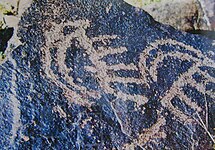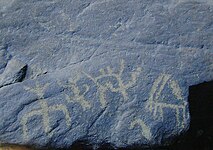Gamigaya Petroglyphs
Gəmiqaya petroqlifləri | |
 | |
 | |
| Location | |
|---|---|
Gamigaya rock carvings (Azerbaijani: Gəmiqaya petroqlifləri) - are dated to the 4th-1st millennia BC including the Bronze and Early Iron Ages in the territory of Ordubad Rayon, not far from Nəsirvaz village’s border and Azerbaijan’s border with Armenia.[1]

Gamigaya (stone ship) – is the name of Gapyjiq summit (3906) - one of the summits of the Lesser Caucasus, where according to a local legend during a flood myth Noah's Ark pulled in to and turned to a stone in due course. There have been found about 1500 punched out and carved rock images of deer, goats, bulls, dogs, snakes, birds, fantastic beings, and also people, carriages and various symbols. Chaotically drawn images of dancing people can be also met among the images.[2]
Many of these images were fixed not far from springs, in the territory of Garangush plateau. Images of people were caved schematically. Single, pair and group images can be also met there. A person’s image near a horse is considered one of the unique ones. [3]
Images of goats pointing to that, goats took a main place in cattle-breeding life of local population. On one of the rocks a painter portrayed a stressed leopard. Realistic drawings of deer are also very interesting. [4]
Gallery



